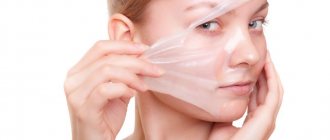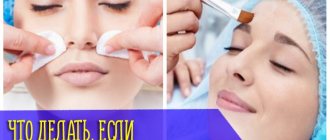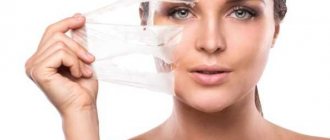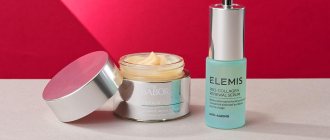Whether it is possible to do peeling before tanning, and after what period of time sunbathing is allowed after the cleansing procedure directly depends on the chosen type of facial cleansing and the type of skin.
It is also recommended to study contraindications for exfoliation before going to the beach or visiting a solarium.
Medium skin peeling
Medium peels are used for skin rejuvenation, because... actively stimulate the production of collagen in the dermis, as well as to combat hyperpigmentation.
Among the most popular: Jessner peel and its modifications, TCA (trichloroacetic peels), retinol/retinoic (also called “yellow peel”).
Medium peeling affects the entire stratum corneum and part of the epidermis. The most likely post-peeling consequences : the occurrence of erythema, the skin will peel, and during the procedure the occurrence of unpleasant sensations in the form of a burning sensation, sometimes accompanied by swelling. All this is normal , and usually the degree of manifestation depends on the number of layers that are applied during the procedure and how deeply the skin is affected!
Sometimes the post-peeling period is accompanied by pustular rashes, which indicates improper preparation of the skin.
Medium peeling is excluded for skin with hypersensitivity.
Healing takes 7 days, during which noticeable peeling, redness and some swelling of the skin are noted. This type of peeling procedure requires the strictest adherence to post-peel care instructions:
Cleanser
If skin barriers are damaged, the cleanser should not foam and contain aggressive surfactants. Only special preparations for delicate and sensitive skin are recommended, in the form of milk, with an oil base.
Example : DermaQuest Cleansing Milk for Delicate Skin is a cleansing milk based on valuable Shea and Jojoba oils with a cream texture. Removes all impurities while restoring damaged barriers of delicate and sensitive skin. Instantly gives skin softness and comfort.
To remove impurities, it is recommended to apply to dry or slightly damp skin, gently massage and remove with a damp cloth.
Protective cream with SPF30
To avoid possible and frequent complications in the form of dark age spots, creams containing physical factors that protect the skin (photo filters) from sunlight are regularly used.
These products are recommended to be used throughout the entire post-peeling period from the moment peeling appears until the integrity of the epidermis is completely restored, regardless of: time of year, sensitivity to the sun/ultraviolet.
Particles of physical (mineral SPF) mechanically protect the skin from rays and remain on the skin throughout the day.
Oil-based serums and creams
They are used to maintain the elasticity of the film formed on the face after peeling and to prevent it from cracking during the first days after the procedure. Maintains a crust, which retains moisture in the tissues to improve regeneration.
Healing and restorative products
When peeling occurs, it is necessary to include in your care products: with a healing effect (based on panthenol and royal jelly) and a restorative effect. Prescribe 2-4 applications per day or as needed to eliminate the feeling of skin tightness.
Lightening agents
Prescribed when working with pigmentation, or if there is a tendency to form it, in order to inhibit the hyperproduction of melanin in response to skin trauma.
It is important to strictly select the product, carefully studying its composition! The drug should not have an irritating or aggressive effect on the skin. Excluded: acids, retinol and hydroquinone .
What happens to the skin after peeling?
During peeling treatment, the upper layer of the epidermis is damaged. The renewed skin is so sensitive that any external influence on it is fraught with dermatological problems. During the period of regeneration of the epidermis, subject to mechanical or chemical cleansing, it should be protected from:
- Ultraviolet rays;
- Wind;
- Frost;
- Various types of pollution.
Among the above factors, ultraviolet radiation is especially dangerous, since under its influence the formation of pigmented areas occurs, which are subsequently quite difficult to get rid of. Therefore, until the skin’s protective reaction is restored after peeling treatment, you should completely avoid exposure to the sun or visiting a solarium.
The time for which sunbathing should be limited depends on the individual recovery of the skin and the aggressiveness of the procedure performed. In addition to pigmentation, unrestored epidermis exposed to sunlight is at risk of photoaging - intense drying of the skin to the state of “parchment paper”, the appearance of a wrinkled network.
IMPORTANT! Photoaging has no age limits. Even at 20 years old, you can get a lot of wrinkles if you don’t follow the rules of post-peeling care.
Superficial-medium peeling
This type of peeling involves the presence of slight peeling, affecting the stratum corneum with minimal penetration of part of the epidermis, and has a milder effect than the average.
The necessary medications for home care are the same as for superficial peeling (see below), however, additional emphasis is placed on:
Regenerating agents
Preparations capable of restoring deep skin barriers (DSE) to restore and protect the skin, as well as to prevent dehydration. These products contain ceramides, Omega 3 and 6 fatty acids, vegetable oils and others. They should be used 2-3 times a day, after cleansing and additionally if the skin feels dry and tight.
Example: Moisturizing cream for delicate skin, daily care DermaQuest - a cream based on valuable Argan, Jojoba, Rosehip oils, antioxidants and moisturizing complexes - instantly softens, moisturizes and creates a soothing barrier for sensitive skin. Relieves irritation and redness.
Useful video
Watch the video about skin care after peeling:
Similar articles
- How to care for your skin after a solarium
There are recommendations from experts on how to tan beautifully in a solarium. In their methods, they use home remedies to enhance your tan, as well as creams and oils to quickly achieve an even tan. Read more - After the solarium
In general, you can understand how to wash after sunbathing by the condition of your skin: it is burned and requires careful care. It is worth noting that you cannot swim immediately. How long after can you take a shower after the sun and solarium? Read more
- Peeling after sunbathing: is it possible to do chemical...
It is allowed to peel after sunbathing, but provided that the skin of the body and face has completely calmed down after exposure to the sun. What kind of peeling is allowed at home and in the salon after the sea, solarium - rejuvenating, chemical and others? Read more
- Sunscreen at sea: which one to choose, which one for...
What you need to consider to choose the right sunscreen at sea. Which one to take to protect children and the elderly. How many tubes of cream are needed for each family member? How to apply sunscreen for face and body at sea. Read more
- Papilloma: is it possible to sunbathe with it even after removal...
If you have papilloma, is it possible to sunbathe in the sun? Is it possible to visit a solarium if there is a formation on the body? Is it possible to sunbathe after removing papillomas? Read more
Superficial skin peeling
Peeling, in which peeling occurs within the stratum corneum of the epidermis and is often not even noticeable to the eye. Peels are carried out once every 7-10 days.
The most popular group of peelings.
- Used for a number of indications : correction of age-related changes (all manifestations of aging, including wrinkles, loss of skin elasticity, etc.), acne, skin with increased oil content, to even out skin tone with hyperpigmentation.
- Superficial peels include AHA-based peels (containing glycolic, lactic, and mandelic acids). The concentration of acids may be different, but they do not penetrate deeply, while actively stimulating cell renewal.
- They are most popular because... effectively combat imperfections, while having a minimal risk of complications and a comfortable rehabilitation period. It will take 5-7 days for the skin to recover.
Protective cream with SPF
Be sure to use sunscreen for 3-7 days during the daytime.
Delicate cleansing
It is selected according to your skin type; it is not necessarily an oil-based product in the form of milk, as with medium peeling. However, it is worth excluding products based on aggressive surfactants with abundant foam formation.
Example : Facial cleansing gel, daily care DermaQuest - enzyme-based cleansing gel for all skin types: quickly removes makeup and impurities, can be used around the eyes. Leaves behind a feeling of cleanliness, hydration and comfort.
Products that restore skin barrier functions
Preparations that have a moisturizing, restorative and anti-inflammatory effect. These can be masks, serums and creams, selected according to your skin type and existing problems.
Choose products enriched with antioxidants to eliminate free radical reactions that inhibit the skin restoration process and can provoke pigmentation.
Active serum for the problem
Superficial peels are minimally aggressive and their effectiveness can be increased by using active serums for the existing skin problem.
Lightening agents
Prescribed if peeling was performed for the problem of age spots. The peeling procedure must be carried out under the cover of 3 types of drugs: antioxidants, lightening agents that block the hyperactivity of melanocytes and products containing photo filters (SPF). It should be remembered that all three types of products must be present in both pre- and post-peel care.
Example: Lightening cream "SkinBright" DermaQuest - lightens age spots, restores and intensively moisturizes, giving the skin a perfectly even tone and radiance. Contains Snow White Lily stem cells, peptides, antioxidants. Does NOT contain hydroquinone or AHA!
Self-preparation
Preparation for acid peeling begins several weeks before the procedure itself. The doctor informs you about the rules of the preparatory period during the preliminary consultation:
- 14 days before peeling, do not visit the solarium or sunbathe naturally, limit trips to the sauna and bathhouse;
- 7 days before peeling, do not apply scrubs containing large solid particles or acid-based cosmetic preparations; use sunscreen 35+ SPF every day;
- eliminate existing inflammatory processes on the skin;
- if there is herpes on the skin, it is necessary to use antibacterial drugs.
If peeling is carried out to eliminate pigmentation, it is recommended to start using products with a whitening effect a week before the procedure.
How to peel your skin effectively and safely
Modern cosmetology users require the most effective products that do not cause skin side effects and restorative procedures, because There is no time to recover and exclude communication (even online).
Classic peelings are effective due to exfoliation and traumatization of the skin - the more peeling, the more pronounced the result.
When choosing a peeling procedure, choose Atraumatic enriched peels , which do not require such strict adherence to recommendations. They help improve the condition of the skin in the safest possible way and allow you not to fall out of the usual rhythm of life (work, sports, communication with people).
Modern atraumatic peelings are a light solution of acids (AHA and/or BHA) and provide light superficial exfoliation. They work due to active ingredients introduced into the peeling solution for skin problems.
Benefits of enriched peelings:
- Does not require rigorous preparation
- Off-season
- Without redness, peeling and irritation of the skin
- Highly effective (comparable to average)
- Possibility of individual selection
Examples: The professional brand DermaQuest provides specialists with a wide range of enriched peels for various problems.
For example, Peptide Peeling - with Botox effect, Pumpkin Peeling - Atraumatic skin cleansing, MangoBright Peeling - against diffuse pigmentation and many others.
Other peelings
Types of peelings include:
- Laser peels , in the case of hardware laser peels, skin restoration depends, as with acid peels, on the depth of grinding and exfoliation of the skin. That is, rehabilitation is determined by the intensity of the laser effect on the skin.
- Scrubs are rarely used in salon treatments as an independent procedure. However, it is important which components (exfoliating particles) are included in the scrub. Typically, regeneration proceeds comfortably, and care corresponds to that for superficial peelings.
- Enzyme peelings. Considered the weakest and most atraumatic, they are sometimes performed before the chemical peeling procedure in order to prepare it for deeper penetration of acids in subsequent stages. And also for contraindications to chemical peels. No special care is required after enzyme peels.











